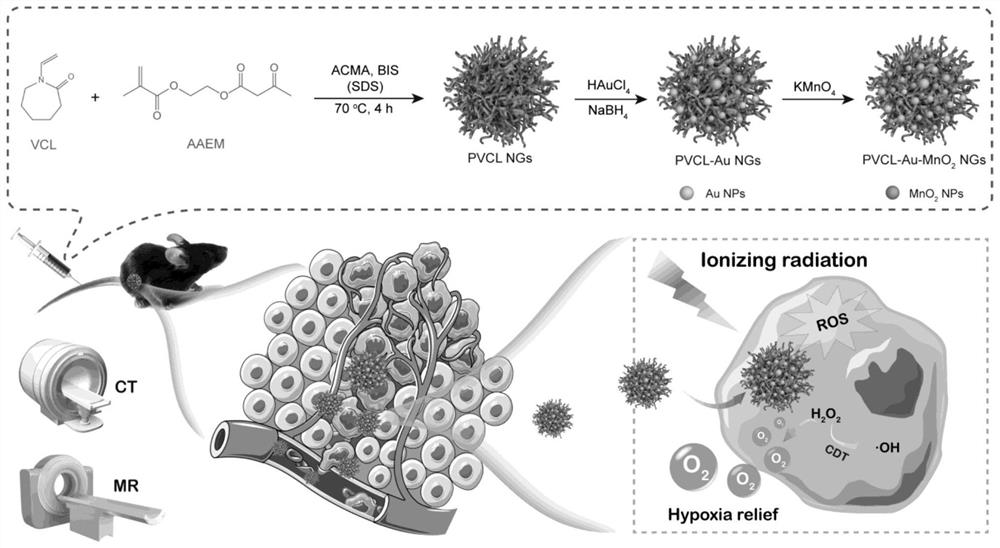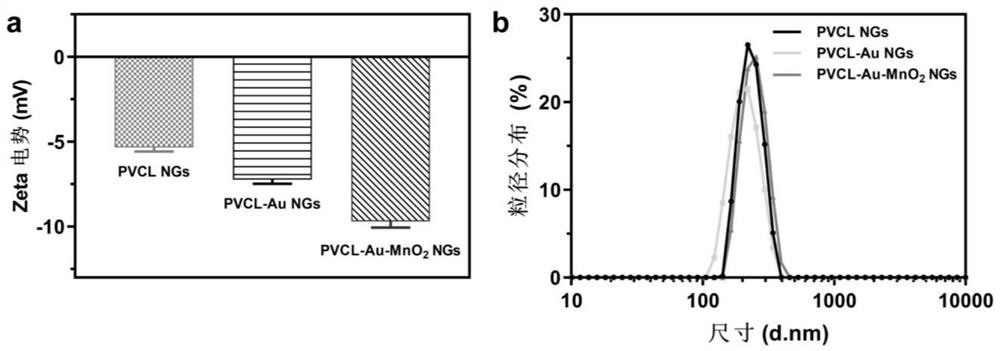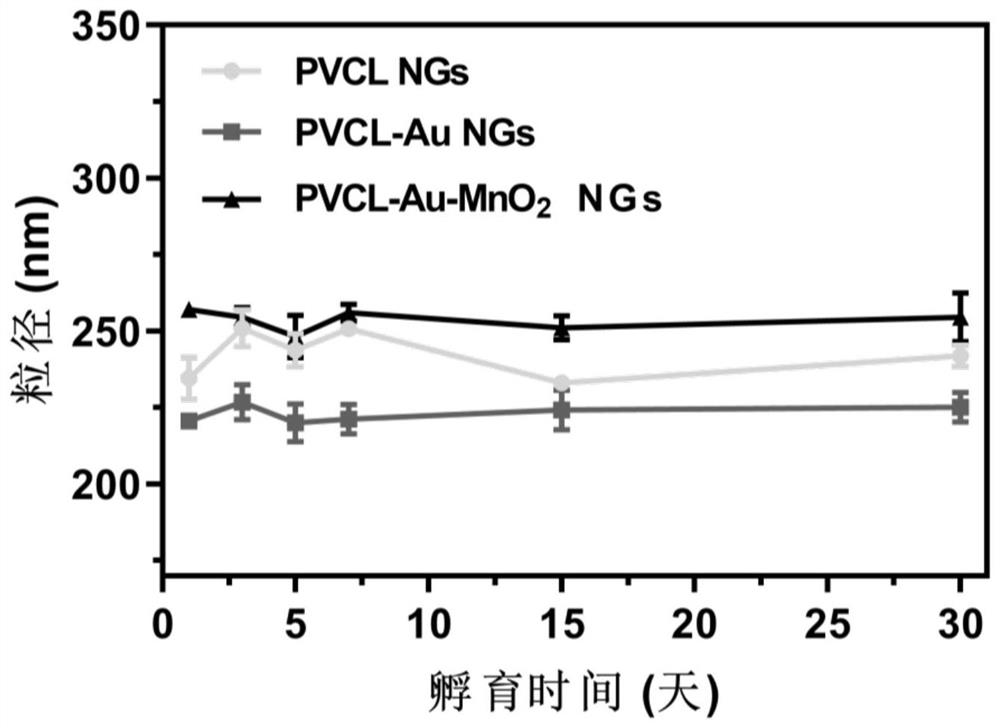Poly (N-vinylcaprolactam) nanogel loaded with gold and manganese dioxide nanoparticles as well as preparation and application of poly (N-vinylcaprolactam) nanogel
A technology of vinyl caprolactam and gold nanoparticles, which can be used in preparations for in vivo tests, medical preparations with inactive ingredients, and medical preparations containing active ingredients, etc., and can solve the problems of low radiotherapy sensitivity of nano-diagnostic agents , to achieve good colloidal stability and cytocompatibility, good development and application prospects, and high r1 relaxation rate.
- Summary
- Abstract
- Description
- Claims
- Application Information
AI Technical Summary
Problems solved by technology
Method used
Image
Examples
Embodiment 1
[0078] (1) Dissolve 469.5mg of N-vinylcaprolactam (VCL), 14.5mg of N,N-methylenebisacrylamide (BIS) and 8.8mg of sodium lauryl sulfate in 30mL of ultrapure water deoxygenated in advance , to which was added 3 mL of acetoacetate methacrylate in water (AAEM, 14 mg / mL), in N 2 Under ambient conditions, stir at 70°C for 30 min. Then, 1.5 mL of an aqueous solution of azodicarboxyethyl-2-isobutylamidine (ACMA, 11.7 mg / mL) was added to the above solution. After stirring and reacting for 5 min, 3 mL of an aqueous solution of AAEM (14 mg / mL) was added to the solution, and stirring was continued for 4 h. Afterwards, the reacted solution was dialyzed in an 8-14kDa dialysis bag for 3 days, and freeze-dried to obtain poly N-vinyl caprolactam nanogel PVCL NGs.
[0079] (2) Disperse the PVCL NGs (100 mg) prepared in step (1) in 18 mL of ultrapure water, then add 1 mL of chloroauric acid aqueous solution (15 mg / mL) dropwise, stir in an ice bath for 30 min, and then quickly add 2 mL of boron...
Embodiment 2
[0082] Get the PVCL NGs, PVCL-Au NGs and PVCL-Au-MnO that embodiment 1 prepares 2 NGs solution (500 μg / mL) was used to measure surface potential and hydrodynamic diameter. The measurement results( figure 2 ) showed that the surface potential of PVCL NGs was −5.31 mV and the hydrodynamic diameter was 207.2 nm. After loading gold nanoparticles, the surface potential changed to −7.25 mV, and the hydrodynamic diameter changed to 215.3 nm, indicating the successful loading of gold nanoparticles. After further in-situ loading of manganese dioxide nanoparticles, the surface potential changed to −9.73 mV, and the hydrodynamic diameter changed to 220.7 nm, indicating the successful loading of manganese dioxide nanoparticles. Meanwhile, PVCLNGs, PVCL-Au NGs and PVCL-Au-MnO 2 After NGs were stored in water for up to 30 days, the size did not change significantly ( image 3 ), indicating the good colloidal stability of the nanogels. Afterwards, measured the PVCL NGs and PVCL-Au-Mn...
Embodiment 3
[0084] The PVCL NGs, PVCL-Au NGs and PVCL-Au-MnO 2 NGs were dispersed in water (1 mg / mL), and the pH was adjusted to 6.5. Subsequently, H was added to each solution 2 o 2 , such that H 2 o 2 The concentration is 100×10 -6 M, then record the change of oxygen in each solution with a dissolved oxygen meter. See attached Figure 7 , compared with the control group (H alone 2 o 2 ) compared to PVCL-Au-MnO 2 The dissolved oxygen concentration in the NGs group was significantly increased, indicating that the PVCL-Au-MnO synthesized by the present invention 2 NGs can well catalyze H under acidic conditions 2 o 2 , and produce oxygen. In contrast, the oxygen concentration in the PVCL NGs and PVCL-Au NGs groups did not change significantly, indicating that PVCLNGs and PVCL-Au NGs could not catalyze H 2 o 2 Oxygen is produced.
PUM
 Login to View More
Login to View More Abstract
Description
Claims
Application Information
 Login to View More
Login to View More - R&D
- Intellectual Property
- Life Sciences
- Materials
- Tech Scout
- Unparalleled Data Quality
- Higher Quality Content
- 60% Fewer Hallucinations
Browse by: Latest US Patents, China's latest patents, Technical Efficacy Thesaurus, Application Domain, Technology Topic, Popular Technical Reports.
© 2025 PatSnap. All rights reserved.Legal|Privacy policy|Modern Slavery Act Transparency Statement|Sitemap|About US| Contact US: help@patsnap.com



